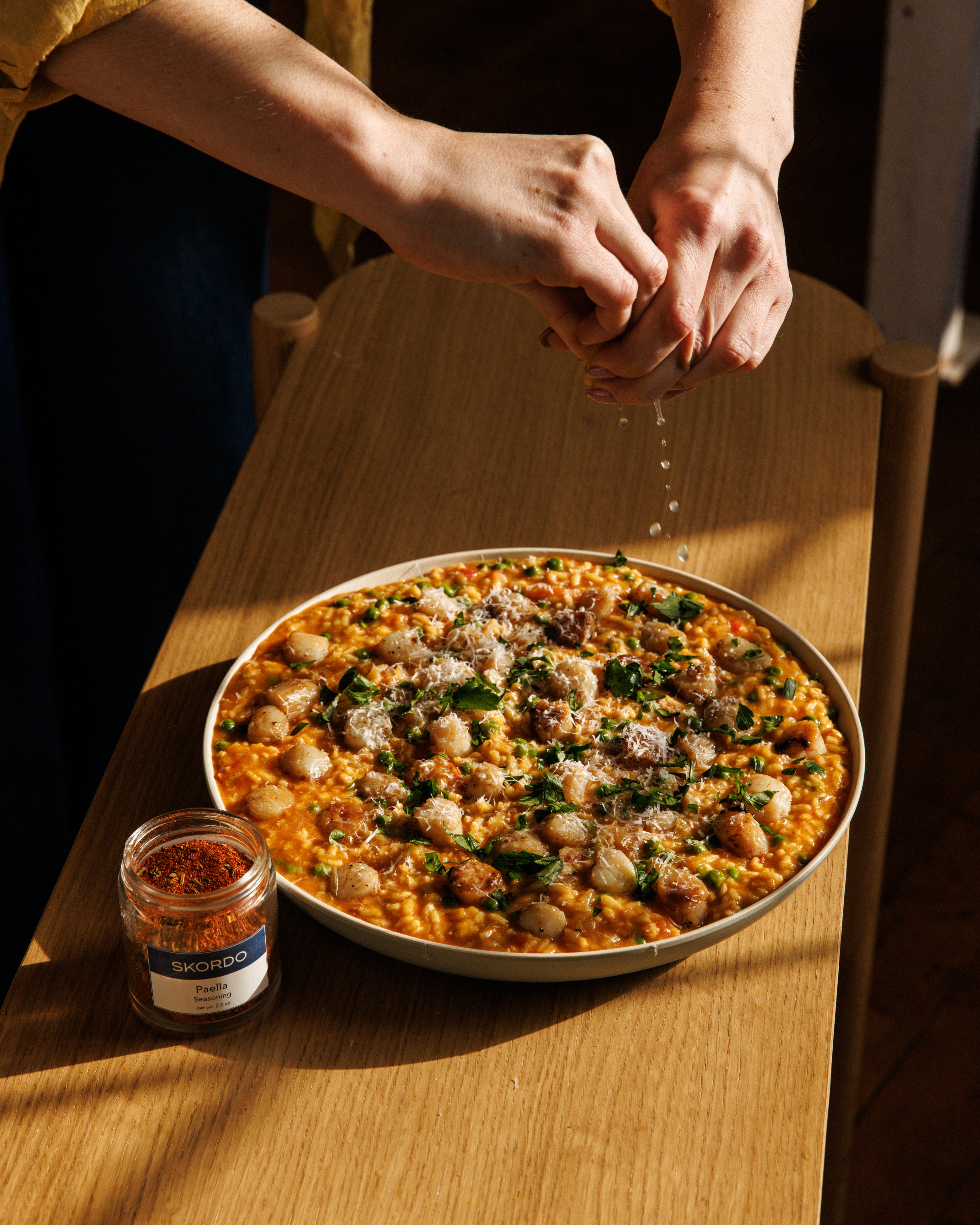Samosas are an Indian delicacy, and street food! The crispy triangle shells perfectly encase a fluffy potato and pea filling loaded with spices. These pack a little heat, but are often served with a cooling chutney or a curried ketchup. We made two edits to turn this traditional pastry into a quick and easy snack. 1) We used ground spices + warmed them in ghee, instead of using whole spices, toasting, and grinding. 2) We used empanada wrappers instead of making fresh dough, egg roll wrappers would work too! A samosa specific dough is pretty simple, and often uses Ajowan seeds or Caraway seeds - great to try if you have the time!
There are some really fun ingredients in this filling... Asafetida is an Indian ingredient that can replicate onion and garlic flavors in a dish, while omitting those alliums. Amchoor is an unripe green mango powder, that introduces a sweet, tart flavor. Kashmiri is an Indian chili powder, it has a bright red color and a slightly smoky flavor. We also used our Garam Masala blend, made up of cumin, coriander, black peppercorns, cloves, cinnamon, cardamom.
Makes 12-15 samosas
Ingredients:
- 2-3 medium yukon potatoes, about 2 cups once diced
- 1/2 cup frozen green peas
- 2 tablespoons ghee, or neutral oil
- 1 tablespoon SKORDO Garam Masala
- 2 teaspoons amchoor
- 2 teaspoons dried cilantro
- 1 teaspoon ground ginger
- 1 teaspoon green serrano chile powder
- 1/2 teaspoon kashmiri chile powder
- 1/4 teaspoon asafetida
- 1-2 teaspoons salt
- 1 tablespoon flour + 1 tablespoon water
- 6-8 frozen empanada wrappers
- 2 cup neutral oil (avocado, canola, grapeseed)
Directions:
- Peel and cube your potatoes into small bites, roughly 1/4" squares.
- Add potatoes to cold water and bring to a boil.
- Just before potatoes are fork tender, add your frozen peas.
- Strain pot and set aside.
- In a large skillet, heat 2 tablespoons ghee or neutral oil. Add your ground spice mixture and toast briefly.
- To the spice mixture, add your potatoes and peas. Saute for 1-2 minutes then remove from heat.
- While filling cools slightly, prepare your wrappers. Using a rolling pin, stretch your round wrapper larger + thinner. Avoid using any flour.
- Make a "glue" by mixing your 1 tablespoon flour with water until a smooth paste forms. This is how you'll seal your samosas.
- Slice each stretched wrapper into halves (semi circles). Working with one half a time, roll your semi-circle into thirds to form a cone shape and seal the edges with your flour paste, being sure to pinch the point sealed as well.

- Finish shaping all of your samosas and set aside.
- In a medium sauce pan, heat your 2 cups of neutral oil, for frying. Oil should be 325-350, but if no thermometer you can test the oil by dropping some spare dough in the oil and making sure it bubbles. It's important the dough cooked through, before it gets too dark!
- When oil is ready, add your first few samosas. My pot could fit 4 per batch. I fry each batch two times. Once your first four are lightly golden, set aside onto paper towels. After all samosas get their first fry, start from the first batch and fry all again until golden brown. Set onto paper towels again to drain.
- Serve with chutney, curried ketchup, or a cooling yogurt sauce- enjoy!

Make them your own:
- try dusting the finish samosas with Chaat Masala
- try making your own dough!
- add different ingredients to the filling (cauliflower, onion, lentils, chickpeas, carrots)
Want to make ghee? It's beneficial to have on hand! It's a stabilized cooking fat with a higher smoking point. You simply simmer sticks of butter over a low heat, and continuously skim the foam from the top. The process is evaporating out the water content and removing the milk solids. After about thirty minutes of skimming, you strain the fat over cheese cloth or a coffee filter and you're good to go! I store mine in a Weck jar, and since the milk solids have been removed, you can store it at room temperature for 3-4 months, or in the fridge for a year.






